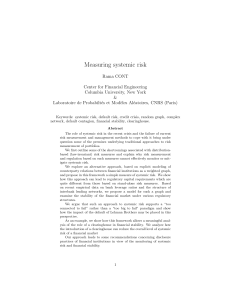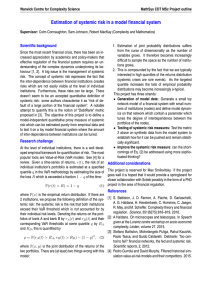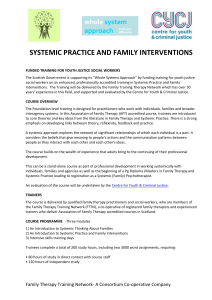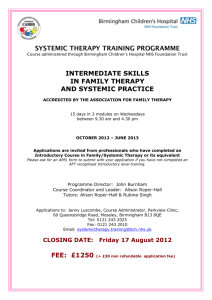William Charney
advertisement
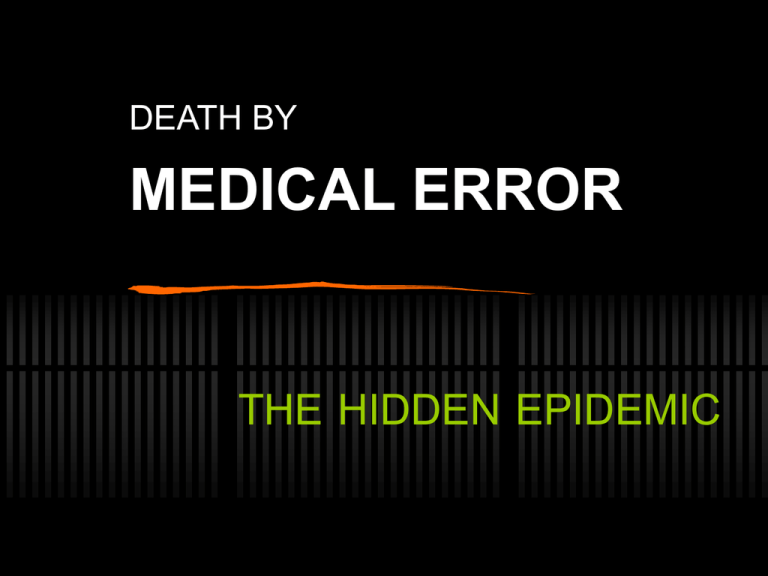
DEATH BY MEDICAL ERROR THE HIDDEN EPIDEMIC By William Charney Editor of “Epidemic of Medical Errors and Hospital-Acquired Infections” What does the term “Medical Error” mean? A combination of medical errors where doctors, nurses or health care workers make mistakes: Medical errors Health care acquired infections Misdiagnoses Medication errors Surgical errors that produce fatality or morbidity Blood clots Hospital-acquired uncontrollable diarrheas Outpatient errors Nursing home errors Medical Error leading cause of death to Americans… over 788,000 per year plus millions of injuries Source: Dr. Gary Null and Joe Graedon, MS, and Teresea Graedon, PhD, “Top Screwups Doctors Make and How to Avoid Them” Medical Error 2nd leading cause of death to Canadians… approximately 56,517 to 63,098 deaths per year plus 552,473 adverse events Source: Extrapolation from Baker Report and the Public Health Agency of Canada Systemic causes of medical error have been built into the design of the systems both in Canada and U.S. Systemic Factors in Medical Error Profit Motive: The Journal of General Internal Medicine published a study in March 2000, titled “Hospital Ownership and Preventable Events”. It showed that patients in for-profit hospitals are 2 to 4 times more likely than patients at not-for-profit hospitals to suffer adverse events such as post surgical complications, delays in diagnosis, and treatment of an ailment. Source: Vol. 15 No. 3 Pgs. 211-219 Factory Medicine in Canada Number of: Patients per day Procedures per day Operations per hour Patients per minute Beds per region Systemic Factors in Medical Error (cont’d.) Staffing: Patients in a hospital with a 1:8 nurse-topatient ratio, have a 31% greater risk of dying than patients in hospitals with a 1:4 ratio. Only state with ratio regulation is California No Canadian province has ratio regulation Source: Aiken, et al; JAMA 288 No. 16 (2002) 1987-92 Systemic Factors in Medical Error (cont’d.) Shift Work: Longer shifts translate into more errors. Physicians who are scheduled to work long hours make 36% more errors with 5 times as many serious diagnostic errors Source: Found in "Epidemic of Medical Error" CRC Press, ed. Charney, Chapter 9 authored by Pontus pp. 191 Systemic Factors in Medical Error (cont’d.) Behavior: A study of 1,700 nurses, physicians, clinical care staff and administrators found fewer than 10% address behavior by colleagues that routinely includes trouble following directions, poor clinical judgment or taking dangerous shortcuts. Specifically, 84% of MDs and 62% of RNs and other clinical care providers had seen coworkers taking shortcuts that could be dangerous to patients…fewer than 10% said they directly confront their colleagues. Systemic Factors in Medical Error (cont’d.) Non and Under Reporting: There are 27 states in the U.S. with reporting regulations Quebec is the only province in Canada that has reporting regulations 5% and no more than 20% of medical error incidents are reported Source: Leape, JAMA 1994, Dec. 21 272(23) 1851-7 Systemic Factors in Medical Error (cont’d.) Working Conditions: Poor working conditions, such as ergonomics, patient developmental flows, staffing, workload, scheduling, and autonomy contribute directly to medical errors. In 115 studies included in a 2003 review, working conditions affect patient safety, the rate of medication errors, and the rate of recognition of such errors after they occur Source: Blum et al; Natural Science Sleep 3 pp. 47-85 Systemic Factors in Medical Error (cont’d.) Accountability: Studies have shown even getting healthcare workers to wash hands between patients or after leaving bathrooms is not enforced and there are low compliance rates 52% of doctors did not wash their hands between patients Source: CDC, 2003 Systemic Factors in Medical Error (cont’d.) Cost-Benefit Analysis: The Society of Actuaries has stated that medical errors are costing $20 billion a year. Bedsores alone account for a cost of $3.9 billion annually. The cost per patient of medical error can be as high as $20,000 per bed (using the American Hospital Association’s data of 1 million hospital beds in the U.S.) Systemic Factors in Medical Error (cont’d.) Injury to Workers: Injury contributes systemically to medical error and compromises patient safety. Injuring a worker leads to a downstream negative patient effect. Source: Charney and Schirmer, AAOHN Journal - American Association of Occupational Health Nurses Journal) Systemic Factors in Medical Error (cont’d.) Bullying: Nurses reported that 71% of bullying behavior resulted in medical error of which 29% resulted in death Source: Rosenstein, et al. Joint Commission Quality Patient Safety 34(8) 467-71 Systemic Factors in Medical Error (cont’d.) Technology: Reliance on technology is not a panacea for solving medical errors. Human factors still apply. Despite computerization of pharmaceutical approaches, 98,000 people per year end up in emergency rooms every year (mostly elderly) due to medication error. Source: New York Times, 2012 Organizations in charge of fixing medical errors are organizations mostly responsible for creating problems Patient advocacy groups and Canadian and American labor unions should lead the struggle to reform health care Organizations in charge of fixing medical errors are organizations mostly responsible for creating problems Patient advocacy groups and Canadian and American labor unions should lead the struggle to reform health care


